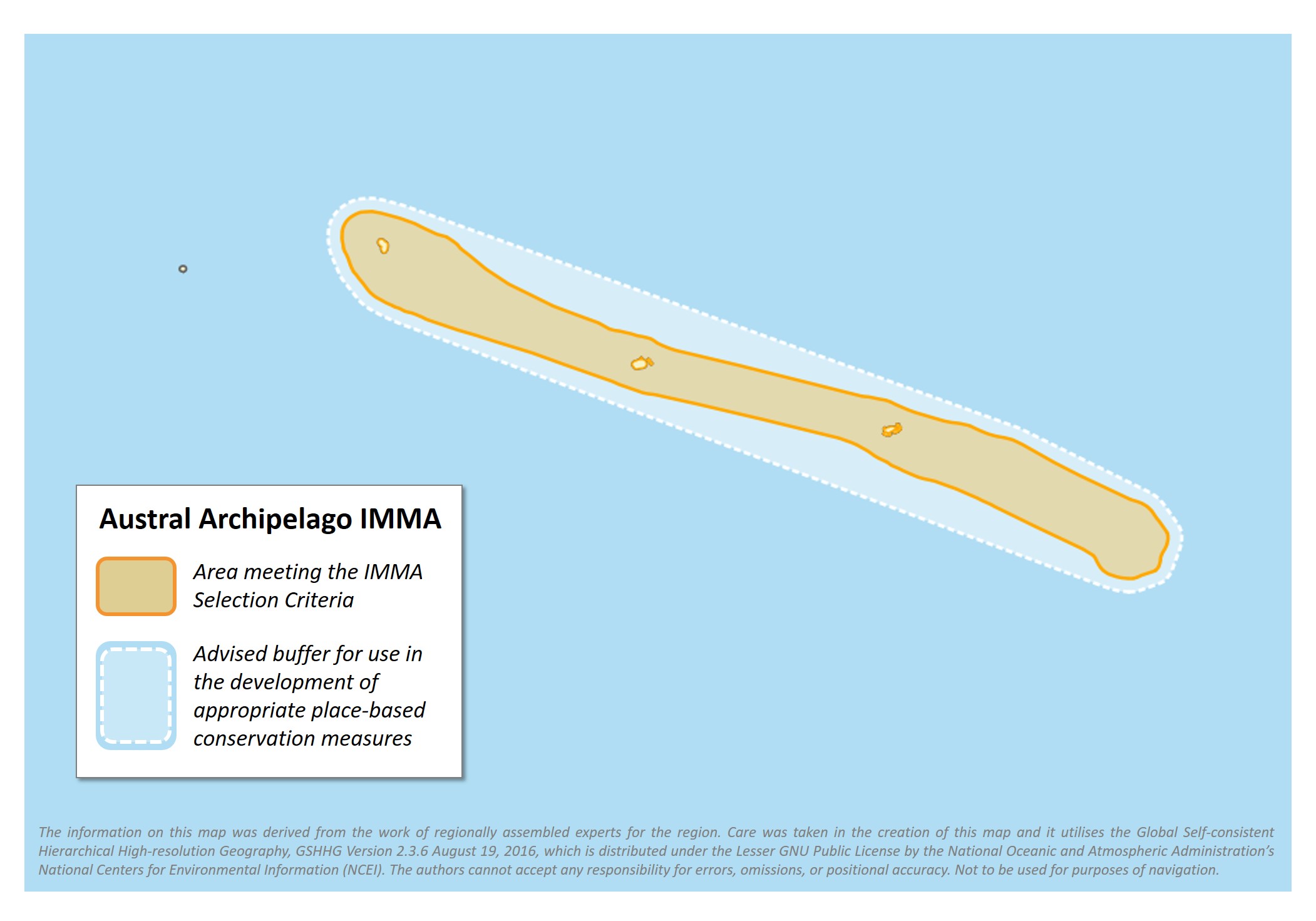Austral Archipelago IMMA
Area Size
32 291 km2
Qualifying Species and Criteria
Humpback whale – Megaptera novaeangliae
Criterion A; B (2); C (1)
Marine Mammal Diversity
Physeter macrocephalus, Stenella longirostris, Tursiops truncatus, Ziphius cavirostris, Mesoplodon densirostris, Stenella attenuata, Steno bredanensis
Download fact sheet
Summary
The Austral Islands are the southern-most archipelago in French Polynesia. Humpback whales from the Oceania subpopulation classified by IUCN as Endangered, regularly aggregate around at least four of the archipelago islands (Rimatara, Rurutu, Tubuai and Raivavae) during the austral winter. Humpback whale group encounter rates are higher around these islands than in any other part of French Polynesia (with the exception of the Windward Islands) and the area has all the characteristics of being an important humpback whale reproductive area. Genetics and photo-ID studies suggest that humpback whales that frequent the Austral Islands are largely separate from those that occur elsewhere in the region. The whales are primarily found close to the shore or to the fringing barrier reef, but, as whales move between and among islands (each separated by approximately 200km), the IMMA includes both the coastal waters of each island, as well as the stretches of water connecting them.
Description of Qualifying Criteria
Criterion A – Species or Population Vulnerability
The humpback whales that visit the Austral Islands, are a part of the larger Oceania humpback whale subpopulation that is classified as Endangered on the IUCN Red List. The Oceania-wide abundance estimate was 4329 (CV = 0.12, CI 3345-5313) whales in 2003 (Constantine et al. 2012) and models suggest that this subpopulation is recovering at a slower rate than other humpback whale populations (Jackson et al. 2007).
Criterion B: Distribution and Abundance
Sub-criterion B2: Aggregations
The nearshore waters of the Austral Archipelago are critical places where humpback whales aggregate for breeding during the winter months. Encounter rates of humpback whales around the Austral Archipelago are amongst the highest in French Polynesia suggesting that this is an important aggregation that may constitute a considerable proportion of the subpopulation. The Islands are an important area for all sex- and age-classes (Gannier 2004, Poole et al. 2014).
Criterion C: Key Life Cycle Activities
Sub-criterion C1: Reproductive Areas
The Austral islands form critical annual winter calving and mating habitat for humpback whales (Gannier 2004, Poole et al. 2014, Poole 1993).
Supporting Information
Albertson-Gibb, R., Poole, M.M., Constantine, R., and Baker, C.S. 2009. Capture-recapture estimation of abundance for humpback whales of French Polynesia (Breeding Stock F) using photo-identification. Report SC/61/SH14 submitted to the Scientific Committee of the International Whaling Commission.
Constantine, R., J. A. Jackson, D. Steel, C. S. Baker, L. Brooks, D. Burns, P. Clapham, N. Hauser, B. Madon, D. Mattila, M. Oremus, M. Poole, J. Robbins, K. Thompson and Garrigue C. 2012. Abundance of humpback whales in Oceania using photo-identification and microsatellite genotyping. Marine Ecology Progress Series, 453: 249-261.
Gannier, A. 2004. The Large-Scale Distribution of Humpback Whales (Megaptera novaeangliae) Wintering in French Polynesia During 1997-2002. Aquatic Mammals, 30(2): 227-236.
Laran, S., Van Canneyt, O., Dorémus, G., Massart, W., Ridoux, V. and Watremez, P. 2012. Distribution et abondance de la mégafaune marine en Polynésie française. REMMOA-Polynésie. Rapport final pour l’Agence des Aires Marines Protégées. 127pp [in French].
Olavarria, C., Baker, C.S., Garrigue, C., Poole, M., Hauser, N., Caballero, S., Forez-Gonzalez, L., Brasseur, M., Bannister, J., Capella, J., Clapham, P., Dodemont, R., Donoghue, M., Jenner, C., Jenner, M.N., Moro, D., Oremus, M., Paton, D., Rosenbaum, H. and Russell, K. 2007. Population structure of humpback whales throughout the South Pacific and the origin of the eastern Polynesian breeding grounds. Marine Ecology Progress Series. 330: 257- 268.
Poole, M.M. 1993. A sighting and stranding network in French Polynesia, 1988-1993. Proceedings of the Tenth Biennial Conference on the Biology of Marine Mammals, Society for Marine Mammalogy, Galveston, Texas.
Poole, M.M. 2002. Occurrence of humpback whales (Megaptera novaeangliae) in French Polynesia in 1988-2001. Report SC/54/H14 submitted to the Scientific Committee of the International Whaling Commission.
Poole, M.M. and Darling, J. 1999. Occurrence of humpback whales (Megaptera novaeangliae) in French Polynesia. Proceedings of the Thirteenth Biennial Conference on the Biology of Marine Mammals., Society for Marine Mammalogy, Hawaii.
Poole, M. M., Albertson, G.R and Oremus, M. 2014. Expedition Austral Islands: Photo-identification, song recording, and biopsy sampling of humpback whales (Megaptera novaeangliae) in southern French Polynesia. Report SC/65b/SH21 to the Scientific Committee of the International Whaling Commission.


